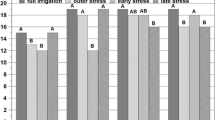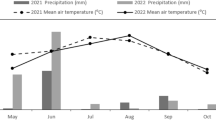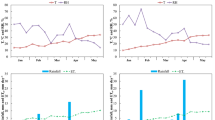Abstract
In most irrigated potato (Solanum tuberosum L.) production systems, the amount of irrigation water applied is equivalent to or greater than evapotranspiration (ET) replacement. ET is mostly estimated for a wide range of potato cultivars, which often leads to over or under irrigation of some cultivars. Studies were conducted at Colorado State University’s San Luis Valley Research Center to evaluate the effect of limited irrigation water below the estimated ET on performance of two new Colorado Russet potato cultivars ‘Mercury Russet’ and ‘Rio Grande Russet’. For Mercury Russet, treatments included 80%, 90%, and 100% ET replacement in 2014, and 70%, 82%, and 100% ET replacement in 2015. Treatments for Rio Grande Russet included 80%, 90%, and 100% ET replacement in 2014, and 79%, 85%, and 100% ET replacement in 2015. A reduction of irrigation water by 20% in 2014 and 30% in 2015 delayed leaf senescence of Mercury Russet until 86 to 90 days after planting (DAP). Tuber yields obtained under 10% and 18% reduced irrigation water equaled yields obtained under 100% ET treatment. For Rio Grande Russet, LAI was not impacted with limited irrigation water in 2014, but in 2015 LAI reduced with 15% or more irrigation water reduction. Limiting irrigation water beyond 20% reduced tuber yields in Rio Grande Russet. Data from these studies indicate that irrigation water applied in the production of Mercury Russet and Rio Grande Russet can be reduced up to 18% and 15%, respectively, without affecting tuber yield and quality.
Resumen
En la mayoría de los sistemas de producción de papa (Solanum tuberosum L.) de riego, la cantidad de agua aplicada es equivalente a, o mayor, al reemplazo por evapotranspiración (ET). La ET se estima mayormente para una gran amplitud de variedades de papa, lo cual a menudo conduce a un excesivo o deficiente riego de algunas variedades. Se condujeron estudios en el Centro de Investigación del Valle de San Luis de la Universidad Estatal de Colorado para evaluar el efecto de agua de riego limitada debajo de la estimación de ET, sobre el comportamiento de dos variedades nuevas del tipo Colorado Russet, “Mercury Russet” y “Rio Grande Russet”. Para Mercury Russet los tratamientos incluyeron 80%, 90%, y 100% de reemplazo de ET en 2014, y 70%, 82%, y 100% de reemplazo de ET en 2015. Los tratamientos para Rio Grande Russet incluyeron 80%, 90%, y 100% de reemplazo de ET en 2014, y 79%, 85% y 100% de reemplazo de ET en 2015. Una reducción del agua de riego del 20% en 2014 y de 30% en 2015 retrasó la senectud de la hoja de Mercury Russet hasta los 86 a 90 días después de la siembra (DAP). Los rendimientos de tubérculo obtenidos bajo una reducción de 10% y 18% del agua de riego igualaron a los obtenidos bajo el tratamiento de 100% de reemplazo de ET. Para Rio Grande Russet, no se impactó el LAI con agua de riego limitada en 2014, pero en 2015 el LAI se redujo con 15% o mas en la reducción del agua de riego. Limitando al agua de riego a mas del 20% se redujeron los rendimientos de tubérculo en Rio Grande Russet. Los datos de estos estudios indican que el agua de riego aplicada en la producción de Mercury Russet y Rio Grande Russet se puede reducir hasta en 18% y 15% respectivamente, sin afectar el rendimiento y la calidad de tubérculo.






Similar content being viewed by others
References
Alenazi, M., M.A. Wahb-Allah, H.S. Abdel-Razzak, A.A. Ibrahim, and A. Alsadon. 2016. Water regimes and humic acid application influences potato growth, yield, tuber quality and water use efficiency. American Journal of Potato Research 93: 463–473.
Ali, G. 2014. Study of the influence of water stress on growth and development of crop plants. International Journal of Pharmaceutical Sciences Review and Research 1: 28–32.
Alva, A.K. 2008. Water management and water uptake efficiency by potatoes: A review. Archives of Agronomy and Soil Science 54 (1): 53–63.
Ayas, S. 2013. The effects of different regimes on potato (Solanum tuberosum L. Hermes) yield and quality characteristics under unheated greenhouse conditions. Bulgarian Journal of Agricultural Science 19: 87–95.
Belanger, G., J.R. Walsh, J.E. Richards, R.H. Milburn, and N. Ziadi. 2002. Nitrogen fertilization and irrigation affects tuber characteristics of two potato cultivars. The American Journal of Potato Research 79: 269–279.
Bohman, B.J., C.J. Rosen, and D.J. Mulla. 2019. Evaluation of variable rate nitrogen and reduced irrigation management for potato production. Agronomy Journal 111: 2005–2017.
Cantore, V., F. Wassar, S.S. Yamac, M.H. Sellami, R. Albrizio, A.M. Stellacci, and M. Todorovic. 2014. Yield and water use efficiency of early potato grown under different irrigation regimes. International Journal of Plant Production 8 (3): 409–428.
Cappaert, M.R., M.L. Powelson, N.W. Christensen, W.R. Stevenson, and D.I. Rouse. 1994. Assessment of irrigation as a method of managing potato early dying. Phytopathology 84: 792–800.
Carli, C., F. Yuldashev, D. Khalikov, B. Condori, V. Mare, and P. Monneveux. 2014. Effect of different irrigation regimes on yield, water use efficiency and quality of potato (Solanum tuberosum L.) in the lowlands of Tashkent, Uzbekistan: A field and modeling perspective. Field Crops Research 163: 90–99.
CoAgmet. 2014. Crop water use. Center, Colorado. https://coagmet.colostate.edu/.
Eldredge, E.P., Z.A. Holmes, A.R. Mosley, C.C. Shock, and T.D. Steiber. 1996. Effects of transitory water stress on potato tuber stem-end reducing sugar and fry color. American Potato Journal 73: 517–530.
Erdem, T., Y. Erdem, H. Orta, and H. Okursoy. 2006. Water yield relationships of potato under different irrigation methods and regimes. Science in Agriculture 63 (3).
Fabeiro, C., F.M. de Santa Olalla, and J.A. de Juan. 2001. Yield and size of deficit irrigated potatoes. Agricultural Water Management 48: 255–266.
Fakhari, R., A. Tube, N. Hasanzadeh, A. Barghi, and M. Shiri. 2013. Studying effects of different irrigation levels land planting patterns on yield and water use efficiency in potato. The International Research Journal of Applied and Basic Sciences 4: 1941–1945.
Gathungu, G.K., A.J. Nyuamori, and K.D. Isutsa. 2016. Improving seed potato leaf area index, Stomatal conductance and chlorophyll accumulation efficiency through irrigation water, nitrogen and phosphorus nutrient management. Journal of Agricultural Studies 4: 127–141.
Gultekin, R., and A. Ertek. 2018. Effects of deficit irrigation on the potato tuber development and quality. International Journal of Agriculture, Environment and Food Sciences 2 (3): 93–98.
Karam, F., R. Lahoud, R. Masaad, C. Stephan, Y. Rouphael, and G. Colla. 2005. Yield and tuber quality of potassium treated potato under optimum irrigation conditions. Acta Horticulturae 684: 103–108.
Karam, F., N. Amacha, S. Fahed, T. El Asmar, and A. Dominguez. 2014. Response of potato to full and deficit irrigation under semiarid climate: Agronomic and economic implications. Agricultural Water Management 142: 144–151.
Kashyap, P.S., and R.K. Panda. 2003. Effect of irrigation scheduling on potato crop parameters under water stressed conditions. Agricultural Crop Management 59: 49–66.
Khakbazam, M., C. Hamilton, R. Mohr, and C. Grant. 2011. Water and nutrient crop sufficiency models for potato, wheat, canola, alfalfa, and corn. The American Journal of Plant Science and Biotechnology 5 (2): 45–60.
Levy, D., W.K. Coleman, and R.E. Veilleux. 2013. Adaptation of potato to water shortage: Irrigation management and enhancement of tolerance to drought and salinity. The American Journal of Potato Research 90: 186–206.
Lynch, D.R., N. Foround, G.C. Kozub, and B.C. Farries. 1995. The effect of moisture stress at three growth stages on the yield, components of yield and processing quality of eight potato cultivars. American Potato Journal 72: 375–386.
Miller, D.E., and M.W. Martin. 1987. Effect of declining or interrupted irrigation on yield and quality of three potato cultivars grown on sandy soil. American Potato Journal 64: 109–117.
Mokh, F.E., K. Nagaz, M.M. Masmoudi, and N.B. Mechlia. 2015. Yield and water productivity of drip-irrigated potato under different nitrogen levels and irrigation regime with saline water in arid Tunisia. American Journal of Plant Sciences 6: 501–510.
Nigon, T. J. 2012. Aerial imagery and other non-invasive approaches to detect nitrogen and water stress in a potato crop. M.S. thesis, University of Minnesota, St. Paul. http://hdl.handle.net/11299/143695. Accessed 13 Jan 2016.
Ojala, J.C., J.C. Stark, and G.E. Kleinkopf. 1990. Influence of irrigation and nitrogen management on potato yield and quality. American Potato Journal 67: 29–43.
Onder, S., M.E. Caliskan, D. Onder, and S. Caliskan. 2005. Different irrigation methods and water stress effects on potato yield and yield components. Agricultural Water Management 73: 73–86.
Painter, C.G., and J. Augustin. 1976. The effect of soil moisture and nitrogen on yield and quality of the russet Burbank potato. American Potato Journal 53: 275–284.
Pavlista, A. D. 1995. Potato production stages: Scheduling key practices. Univ. Nebraska Ext. Circ. #1249. Potato education guide. http://cropwatch.unl.edu/web/potato/key_production_stages.
Pavlista, A.D. 2015. Scheduling reduced irrigation on ‘Atlantic’ potato for minimal effect. The American Journal of Potato Research 92: 1–11.
Reddy, T.Y. and G.H. Reddi. 2002. Irrigation water management. In Principles of Agronomy. Kalyani Publishers, Rajendranagar, Ludhiana:257–334.
Rosegrant, M.W., and S.A. Cline. 2003. Global food security, challenges and policies. Science 302: 1917–1919.
Sark, J.C., S.L. Love, V.A. King, J.M. Marchall, W.H. Bohl, and T. Salaiz. 2013. Potato cultivar response to seasonal drought patterns. The American Journal of Potato Research 90: 307–316.
SAS Institute. 2013. The SAS system for windows. Release 9.4. Cary: SAS Institute Inc.
Shae, J.B., D.D. Steele, and B.L. Gregor. 1999. Irrigation scheduling methods for potatoes in the northern Great Plains. Transactions of ASAE 42: 351–360.
Shock, C.C., J.C. Zalewski, T.D. Stieber, and D.S. Bumett. 1992. Impact of early season water deficits on russet Burbank plant development, tuber yield and quality. American Potato Journal 69: 793–803.
Shock, C.C., Z.A. Holmes, T.D. Stieber, E.P. Eldredge, and P. Zhang. 1993. The effect of timed water stress on quality total solids and reducing sugar content of potatoes. American Potato Journal 70: 227–241.
Shock, C.C., A.B. Pereira, and L.D. Saunders. 1998. Potato yield and quality response to deficit irrigation. HortScience 33: 655–659.
Shock, C.C., E.B.G. Feibert, and L.D. Saunders. 2003. ‘Umatila russet’ and ‘russet legend’ potato yield and quality response to irritation. Horticultural Science 38: 1117–1121.
Shock, C.C., A.B. Pereira, and E.P. Eldredge. 2007. Irrigation best management practices for potato. The American Journal of Potato Research 84: 29–37.
Stark, J.C. and S.L. Love. 2003. Determining tuber specific gravity. In: Potato production systems. J.C. Stark and S.L. Love (co-editors). University of Idaho Extension. Page 332.
Stark, J.C., and I.R. McCann. 1992. Optimal allocation of limited water supplies for russet Burbank potatoes. American Potato Journal 69: 413–421.
Steyn, J.M., D.M. Kagabo, and J.G. Annandale. 2007. Potato growth and yield response to irrigation regimes in contrasting seasons of a subtropical region. African Crop Science Conference Proceeding 8: 1647–1651.
Thornton, M.K. 2002. Effects of heat and water stress on the physiology of potato. Idaho: Idaho potato conference.
Tourneux, C., A. Devaux, M.R. Camacho, P. Mamant, and J.F. Ledent. 2003. Effects of water shortage on six potato genotypes in the highlands of Bolivia (1): Morphological parameters, growth and yield. Agronomie 23: 169–179.
Vos, J., and A.J. Haverkort. 2007. Water availability and potato crop performance. In Potato biology and biotechnology advances and perspectives, ed. D. Vreugdenhil, J. Bradshaw, C. Gebhardt, F. Govers, M.A. Taylor, D.K.I. Mckerron, and H.A. Ross, 333–351. Amsterdam: Pub. Elsevieer.
Waddell, J.T., S.C. Gupta, J.F. Moncrief, C.J. Rosen, and D.D. Steele. 1999. Irrigation and nitrogen management effects on potato yield, tuber quality, and nitrogen uptake. Agronomy Journal 91: 991–997.
Wright, J.L., and J.C. Stark. 1990. Potato. In Irrigation of agricultural crops, ed. B.A. Stewart and D.R. Nielson. Madison: American Society of Agronomy, Crop Science Society of America Soil Science Society of America.
Yuan, B., S. Nishiyama, and Y. Kamg. 2003. Effects of different irrigation regimes on the growth and yield of drip-irrigated potato. Agricultural Water Management 63: 153–167.
Acknowledgements
We thank the Colorado Potato Administrative Committee (CPAC) Areas II and III for their financial support of this project. Our sincere gratitude also goes to Erik Wardle in the department of Soil and Crop Sciences for his tremendous help in the field.
Author information
Authors and Affiliations
Corresponding author
Rights and permissions
About this article
Cite this article
Essah, S.Y., Andales, A.A., Bauder, T.A. et al. Response of Two Colorado Russet Potato Cultivars to Reduced Irrigation Water Use. Am. J. Potato Res. 97, 221–233 (2020). https://doi.org/10.1007/s12230-020-09771-7
Published:
Issue Date:
DOI: https://doi.org/10.1007/s12230-020-09771-7




